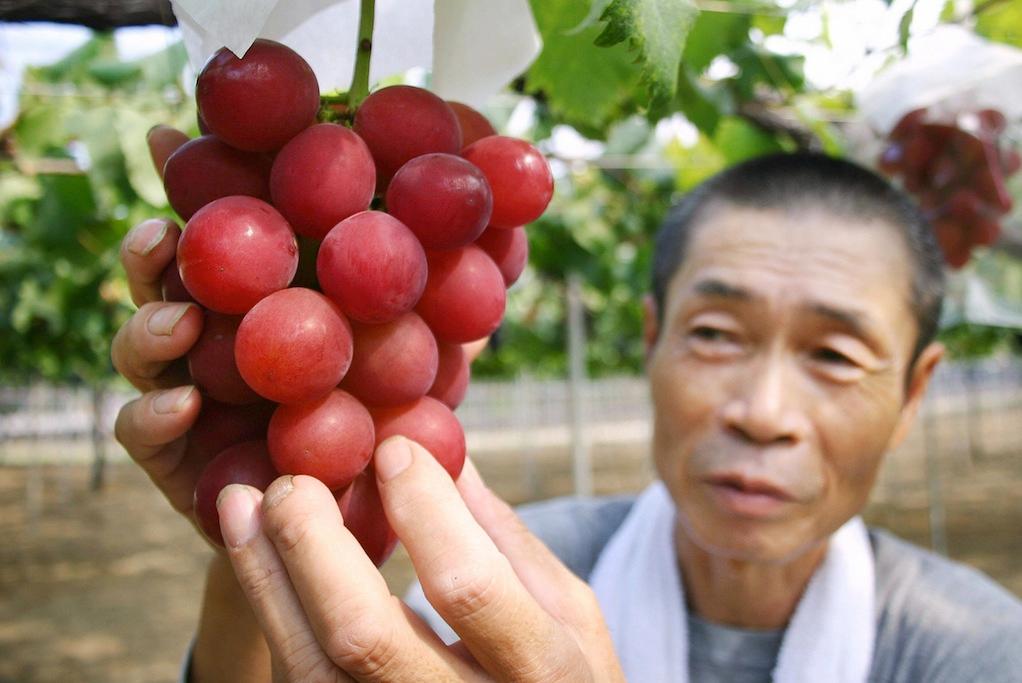East Asia’s flawless fruit fetish
Japanese farmer Tsutomu Takemori displays a cluster of recently-developed “Ruby Roman” grapes at his vineyard in Kahoku city in Ishikawa prefecture. In South Korea and Japan, designer fruit is in high demand as a gift during holidays.
SEOUL, South Korea — Some melons are so pricey that even thieves target them.
In Japan and, to a lesser extent, South Korea, fruit fuels a lucrative boutique business. Shops sell only the best hand-picked “designer fruits”— free from blemishes and spoil.
In Tokyo, one designer apple can fetch around $15. A spotless, plump muskmelon can soar to $100 or more. Japan’s oldest family-run fruit shop, the Sembikiya fruit emporium, peddles grapes that fetch about $60 per box.
In other words, this is fruit’s answer to the Gucci handbag.
It may sound gimmicky, but bite into one, and you’ll see why they’re priced so high. Jumbo apples and grapes are tart and packed with taste, and are so eye-appealing you’d think they’re genetically engineered in a spotless white laboratory. (They weren’t.)
When presenting fruit as a gift in East Asia, immaculate packaging matters. Unlike your typical Whole Foods fare, these fruits come wrapped in perfectly symmetrical arrangements, each morsel padded against bruising. The boxes often sport fancy motifs and delicate ribbons.
The secret to such eye-popping produce lies in the intensive and costly growing process. High-end Japanese cantaloupe farmers gobble up electricity keeping greenhouses at an ideal temperature. They preen the plants carefully so each cantaloupe — often one per plant to retain sweetness — grows at the ideal height.
One well-known craftsman even lays plastic hats on top of his cantaloupes to prevent what sellers call “sunburn.”
Yes, like people, fruits can get sunburned. Too much exposure to the sun can cause their skin to peel. For some fruits, the exterior can turn brown and spoil.
Of course, if you’re marketing your fruit as flawless, any sun-sore spot would lead to a steep discount.
So why the expensive fruit fetish?
Historically, Japanese farmers enjoyed abundant high-quality rainfall. Vegetable harvests were bountiful — meaning locals could get their vitamins without fruit. In contrast, in Europe the water tended to have excessive mineral content, which made life difficult for farmers. Vitamin-packed vegetables were in short supply, so fruit became a cultural staple, used in wine, preserves and juices.
Meanwhile, the landscape in northeast Asia is rugged, leaving less loom for agriculture. As such, fruits were always considered a luxury.
Like the Japanese, South Koreans are avid about purchasing well-packaged, sweet fruits — although the prices in Seoul tend not to be as astronomical. Culturally, a gift of pears, melons, or jumbo apples is a sign of good will. Koreans tend to splurge on fruit on two holidays: Chuseok, a sort of Korean Thanksgiving held this year in September,and Seollal, the Lunar New Year, usually in February.
The French have their appelation d’origine controlee to identify the provenance of fine wines, cheeses and other products. Likewise, South Koreans can be choosy about where fruits are grown. Succulent apples and pears from Sangju, in the central part of the country, can fetch a small fortune, along with grapes from the southwest and west.
“Having those wholesome fruits from those areas can raise the price,” explains Kim Bo-Sung, a fruit vendor in Incheon, a city to the west of Seoul. But, he added, unscrupulous dealers have no problem lying about the origins of their product, and overcharging customers for a low-quality goods.
In other words, buying designer fruit from a street vendor can be like finding the right luxury handbag. Fakes are prevalent and, of course, you run the risk of rip-offs.
The industry faces other challenges, too. Since last summer, “Abenomics,” or Japan’s economic project of monetary stimulus and restructuring, has led to a raft of watermelon thefts in the Japanese countryside.
For farmers, the Abenomics stimulus fomented a rise in the stock market and a spike in the price of fertilizer and raw materials. As the cost of living went up and residents felt the squeeze, a few of them took to stealing, well, expensive watermelons from farms and retail shops.
In one town, Chikusei, farmers reported the disappearance of hundreds of pricey watermelons, the start of an apparent trend. Another prefecture called Tottori has claimed fame as the producer of high-end watermelons shipped to the royal family of the United Arab Emirates (UAE). They, too, have been targeted in recent thefts.
Park Jeong-min contributed reporting.
